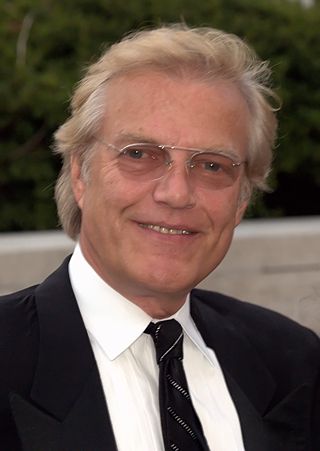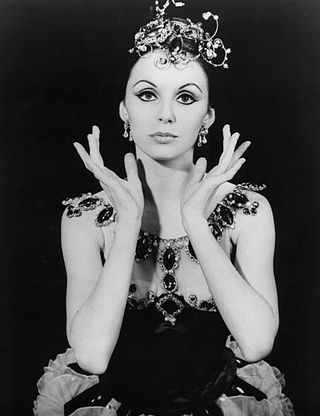Related Research Articles

New York City Ballet (NYCB) is a ballet company founded in 1948 by choreographer George Balanchine and Lincoln Kirstein. Balanchine and Jerome Robbins are considered the founding choreographers of the company. Léon Barzin was the company's first music director. City Ballet grew out of earlier troupes: the Producing Company of the School of American Ballet, 1934; the American Ballet, 1935, and Ballet Caravan, 1936, which merged into American Ballet Caravan, 1941; and directly from the Ballet Society, 1946.

The Joffrey Ballet is an American dance company and training institution in Chicago, Illinois. The Joffrey regularly performs classical and contemporary ballets during its annual performance season at the Civic Opera House, including its annual presentation of The Nutcracker.

Peter Martins is a Danish former ballet dancer and choreographer. Martins was a principal dancer with the Royal Danish Ballet and with the New York City Ballet, where he joined George Balanchine, Jerome Robbins, and John Taras as balletmaster in 1981. He retired from dancing in 1983, having achieved the rank of danseur noble, becoming Co-Ballet Master-In-Chief with Robbins. From 1990 until January 2018, he was solely responsible for artistic leadership of City Ballet.

San Francisco Ballet is the oldest ballet company in the United States, founded in 1933 as the San Francisco Opera Ballet under the leadership of ballet master Adolph Bolm. The company is currently based in the War Memorial Opera House, San Francisco, and effective December 2022 under the direction of Tamara Rojo. It is among the world's leading dance companies, presenting more than 100 performances annually, with a repertoire that spans both classical and contemporary ballet. Along with American Ballet Theatre and the New York City Ballet, San Francisco Ballet has been described as part of the "triumvirate of great classical companies defining the American style on the world stage today."
Lawrence Pech is a dancer, choreographer and teacher currently living and working in the San Francisco Bay Area.
John Taras was an American ballet master, repetiteur, and choreographer.
Tarantella is a ballet choreographed by George Balanchine to Grande Tarantelle by Louis Moreau Gottschalk, arranged by Hershy Kay. The ballet premiered on January 7, 1964, at the New York City Center, performed by New York City Ballet's Patricia McBride and Edward Villella.

Patricia McBride is a ballerina who spent nearly 30 years dancing with the New York City Ballet. McBride joined the New York City Ballet in 1959. She became a principal in 1961, becoming the company's youngest principal. She danced with the company for 30 years, including roles created for her by choreographers George Balanchine and Jerome Robbins.
Gonzalo Garcia is a Spanish American ballet dancer. He joined the San Francisco Ballet in 1998, and was promoted to principal in 2002, at age 22. In 2007, he left the company and joined the New York City Ballet. He retired from performing in 2022 and remains in the company as a repertory director.
Symphony in Three Movements is a neoclassical ballet choreographed by George Balanchine to the music of the same name by Stravinsky. The ballet was made for the New York City Ballet Stravinsky Festival in 1972, a tribute to the composer following his death. The ballet premiered on June 18, 1972, at the New York State Theater.
Katita Waldo is a Spanish ballet dancer and ballet master. She joined the San Francisco Ballet in 1988, was promoted to principal dancer in 1994, and retired from performing in 2010, but remains in the company as a ballet master.
Tina LeBlanc is an American ballet dancer, teacher and ballet master. She joined the Joffrey Ballet in 1988. In 1992, she joined the San Francisco Ballet as a principal dancer. She retired in 2009, then joined the faculty of the San Francisco Ballet School, before returning to the San Francisco Ballet as a ballet master in 2019.

Who Cares? is a ballet choreographed by George Balanchine to songs by George Gershwin that were orchestrated by Hershy Kay. The ballet is split in two parts, the first danced by an ensemble, and the second focuses on four principal dancers. Who Cares? premiered on February 5, 1970, at the New York State Theater, danced by the New York City Ballet.

Ann Marie DeAngelo is an American choreographer, director, producer, teacher, consultant and former dancer - an expert in all areas of dance. She was leading ballerina with the Joffrey Ballet, where early on she was pegged by Time magazine as "one of America's most outstanding ballerinas" and where she later served as associate director at the time of the company's move to Chicago in 1995.
Molly Smolen is an American ballet dancer.
Tchaikovsky's now-classic 1892 ballet The Nutcracker received its first complete production in the U.S. on 24 December 1944, performed by the San Francisco Ballet. This production used the ballet's original plot and was choreographed by Willam Christensen, who danced the role of the Cavalier. Gisella Caccialanza, the wife of Lew Christensen, danced the role of the Sugar Plum Fairy. The staging was a huge success and one critic wrote: "We can't understand why a vehicle of such fantastic beauty and originality could be produced in Europe in 1892 with signal success [a factually erroneous claim] and never be produced in its entirety in this country until 1944. Perhaps choreographers will make up for lost time from now on." The company was the first in the U.S. to make the ballet an annual tradition, and for ten years, the only company in the United States performing the complete ballet, until George Balanchine's production opened in New York in 1954.
Christopher Stowell is an American ballet dancer and choreographer. He is currently the associate artistic director of the National Ballet of Canada. He was previously the artistic director of the Oregon Ballet Theatre. Before that, he danced professionally with the San Francisco Ballet for sixteen years.
Maria Calegari is an American ballet dancer, teacher and répétiteur. She joined the New York City Ballet in 1974 and became a principal dancer in 1983. She left the company in 1994, then occasionally performed until 2004. She also teaches ballet and began working as a répétiteur for the Balanchine Trust and Robbins Rights Trust in 1996 and 2003 respectively.
References
- ↑ "Helgi Tomasson: Executive Profile & Biography". Bloomberg Businessweek. Archived from the original on December 3, 2013. Retrieved November 27, 2013.
- ↑ "Dansaði sig á toppinn". mbl.is. Retrieved July 7, 2022.
- 1 2 Kisselgoff, Anna (January 29, 1985). "Helgi Tomasson Farewell Performance". New York Times. Retrieved October 21, 2013.
- 1 2 3 4 5 Ulrich, Allan (January 23, 2005). "20 years of Helgi". SFGate.com.
- 1 2 "San Francisco Ballet – The Company – Artistic Director". Archived from the original on July 30, 2018. Retrieved November 7, 2007.
- ↑ "Dance in America: San Francisco Ballet's Nutcracker". PBS Great Performances website. December 7, 2010. Retrieved October 29, 2013.
- ↑ Kisselgoff, Anna (December 21, 2004). "SAN FRANCISCO BALLET REVIEW; Clara and her 'Nutcracker' Friends Stop By the World's Fair". New York Times website. Retrieved October 29, 2013.
- ↑ Anderson, Jack (April 23, 1995). "DANCE; Varied as the Nations, United in Dance". New York Times website. Retrieved October 29, 2013.
- ↑ Zinko, Carolyne (March 1, 2010). "San Francisco Ballet gala celebrates Tomasson". SFGate website. Retrieved October 29, 2013.
- ↑ Libbey, Peter (January 6, 2021). "Helgi Tomasson to Step Down at San Francisco Ballet". New York Times.
- ↑ "Helgi Tomasson, 2012 Dance/USA Honor Honoree". Dance/USA Magazine. Archived from the original on December 13, 2013. Retrieved October 29, 2013.
- ↑ Cappelle, Laura (September 8, 2012). "Steps in the right direction". Financial Times. Financial Times website. Retrieved October 29, 2013.